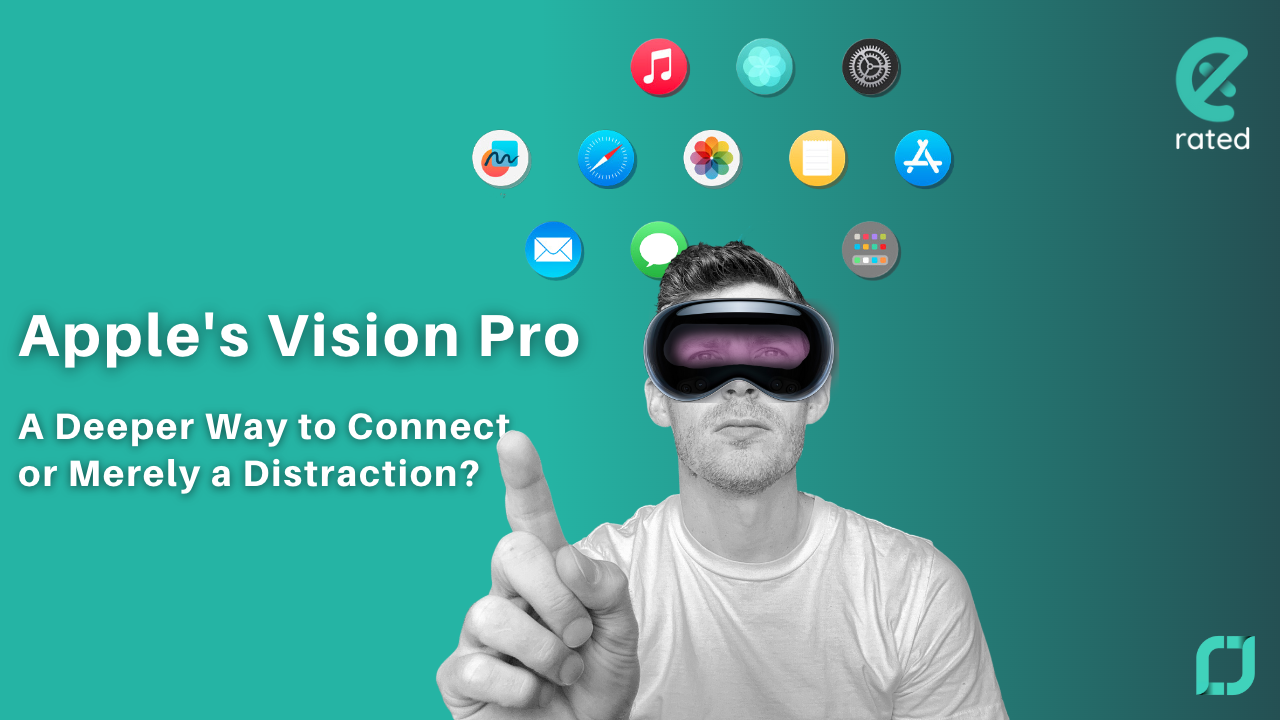Jun18

G’day, G’day,
Well, the internet is abuzz ever since Apple announced the Vision Pro. With over 50 million views of the introduction video on YouTube in a week, this new tech is making waves – More than just an augmented or virtual reality headset Apple calls it a “spatial computer”.
I’m expecting a call from Apple any moment now to confirm my address (I know you have it Apple) as to where they can send me one to test drive so I can have a first-hand experience to share with you all. However, while I await said call, I thought I’d pose some thoughts about the potential social impacts of the everyday adoption of augmented reality (AR).
Despite the initial jaw-dropping price of $3,500 ($5,170 Aussie + GST) I still believe the Vision Pro is the first product that will inspire the mass adoption of AR. Apple has a great track record of propelling the masses forward and breaking moulds. Take the AirPods for example. Prior to the AirPod, anyone walking around with a wireless headset on was either a private chauffeur, a stockbroker, or a wanker. But then the AirPods come along and walking around looking like you’re talking to yourself or bopping along to the latest country song with no cord attached to a device was completely socially normal and acceptable if you had two white buds in your ear.
Augmented reality (AR) isn’t new, in fact, it has been around since 1968 when pioneer Ivan Sutherland developed the ‘Sword of Damocles’ at the University of Salt Lake City. It was a head-mounted device that allowed you to view images in 3D such as a wireframe cube overtop of your surroundings. AR sometimes referred to as XR (extended reality) overlays virtual elements on the real world, offering exciting possibilities in various domains. I’ve read a lot of articles since the launch of the Vision Pro and proponents argue that AR has the potential to revolutionise human interaction, while sceptics view it as a mere distraction from reality. I want to put to you both perspectives to get you thinking as to whether augmented reality is a deeper way to connect or a new way to disconnect and escape from everything around us.
Enhanced Social Experiences: AR has the potential to redefine social interactions. With AR, people can engage in immersive shared experiences, further breaking down physical barriers. For example, AR-powered video conferencing can enable virtual meetings where participants can feel as if they are in the same room, fostering deeper connections despite geographical distances. Something many have wrestled with thanks to working from home becoming a normal standard practice.
Imagine what contact centres could look like. Customer Service Representatives could greet you virtually face to face and sit down for a conversation, working with you on what feels like the same screen to help you navigate and solve your issue. More like a virtual branch than a contact centre.
Augmented reality offers a dynamic and interactive learning environment. Students can visualise complex concepts, engage in realistic simulations and even manipulate virtual objects. This immersive approach enhances understanding and retention, making education more engaging and meaningful.
AR could provide a deeper connection to cultural heritage. By overlaying historical information, stories, and virtual artifacts onto physical spaces, AR applications can offer interactive and educational experiences at historical sites and museums, bridging the gap between the past and the present. Imagine for example conducting a welcome to country (an acknowledgment of the traditional owners of the land in Australia) where the environment around you has transformed from an office environment to a vision of what the land was like before the colonisation of Australia.
AR has the potential to transform collaborative work environments. With AR, team members can share real-time information, collaborate on virtual objects, and co-create in a more seamless manner. This fosters deeper connections and enables efficient teamwork, regardless of physical location. AR adds a tactile element to virtual meetings that screen sharing and video calls cannot compete with.
So, what about the flip side?
Escapism and Overindulgence: One of my concerns is that AR may encourage escapism, as people immerse themselves in virtual experiences rather than engaging with the real world. Overindulgence in AR could lead to social disconnection and a loss of human-to-human interaction, negating the potential for deeper connections. When I think about how addicted so many of us are to screens, I begin to wonder if this takes it to a whole new level. Right now, it’s easy to call someone out about looking at a screen whilst they should be present in the moment. With AR you will not know if someone is looking at you or if they have overlaid with you a T-Rex head.
With augmented reality, there is a risk of overwhelming users with excessive information and distractions. The human attention span is declining at a rapid rate. A study by Microsoft in Canada conducted in 2015 that since the mobile revolution in 2000, the average human attention span dropped from 12 seconds to 8 seconds. That’s a 0.266 reduction each year. If that trend continued it means that you are probably no longer reading this article and your attention span is about 5.87 seconds long. This explains why my short ‘n sweet videos get 5 times the views as articles like this. If AR applications bombard users with constant notifications, advertisements, and content, it will no doubt hinder genuine connections and hinder focus on the present moment. I can barely focus on a conversation if the radio is playing let alone transforming my loungeroom into the Serengeti whilst talking about the logistics of school drop-off.
While on the topic of overload, A study by the American Journal of Preventative Medicine found that people who were high users of social media and technology felt more socially isolated. Right now, with a smartphone, there is a space between your hands and your eyes that requires purposeful movement. It’s subtle but it requires someone to be either looking at their device. You can’t be looking at two places at once. If someone is to avoid walking in front of a car they must look up from the phone. Sure, plenty of annoying people don’t but what I am getting at is when you look up you disconnect even if it is briefly.
AR is different. It’s like a heads-up display on car dashboards. You can focus on two things at once and that information is constant. One reason AR has not been widely adopted to date is because of a lag between our reality and what is digitally overlaid. That lag causes us to become nauseated making long sessions of AR unsustainable. The Vision Pro however is said to have overcome this thanks to not one but two chips. The powerful M2 chip and a new chip called the R1, which is responsible for real-time processing, eliminating the lag that often causes nausea.
This is an amazing feat however if we are now no longer even getting micro-breaks from our devices then that means we will be constantly processing multiple layers of information all the time. So, the question is: Will this ability to be always connected lead to us actually being more socially isolated?
AR blurs the line between reality and virtuality, which raises some ethical concerns in my mind. Privacy, security, and consent become essential issues when digital overlays can intrude upon personal spaces or collect and exploit user data. It’s often said if you want to overcome your fear of speaking in public that you imagine everyone in their underwear. We say it light-heartedly knowing it’s unlikely someone is really doing that but how would you feel if someone was actually able to overlay your body with AR so that it looked like you were in your underwear? This could all be possible; I mean if a Snapchat filter can make me look like a unicorn that vomits rainbows, then is the idea of a “suffer in your jocks” filter that far-fetched? If not carefully managed, these concerns and many more such as people recording your private data unknowingly could overshadow the potential for mainstream use.
If I have any hope of Apple letting me test one of these puppies out, (highly unlikely) and for full disclosure to you as a reader I should say that I’m unashamedly an Apple fan and am pretty excited by their latest announcement. I’m by no means an expert on the Vision Pro and have only relayed here what I have read and watched online. That said, the Vision Pro (in my opinion) is likely to leapfrog AR into mainstream adoption and push the boundaries of what we thought was possible.
I believe augmented reality presents a unique blend of opportunities and challenges. While it has the potential to revolutionise human interaction, fostering deeper connections in some domains, caution must be exercised to avoid potential disconnection, distraction, and ethical pitfalls.
To harness the true potential of AR, developers, researchers, and us as users must strive to strike a balance between the virtual and the real. By leveraging augmented reality as a tool to enhance human experiences, promote collaboration and preserve (even enhance) culture, we can unlock its transformative power while mitigating the risk of distraction and disconnection.
Ultimately, the future of augmented reality lies in our ability to harness its potential responsibly and purposefully, ensuring that it serves as a bridge rather than a barrier in our quest for deeper human connections. That and our ability not to laugh at everyone wearing ski goggles down the street.
I would love to know your thoughts on this. Are you excited by this, what benefits or pitfalls could mass adoption of AR bring forth?
-
Until next time and as always
Hooroo
Keywords: AR/VR, Customer Experience, Future of Work
 The Board Chair as the Primary Lever of Psychological Safety
The Board Chair as the Primary Lever of Psychological Safety Friday’s Change Reflection Quote - Leadership of Change - Change Leaders Maintain Trust and Legitimacy
Friday’s Change Reflection Quote - Leadership of Change - Change Leaders Maintain Trust and Legitimacy The Corix Partners Friday Reading List - January 16, 2026
The Corix Partners Friday Reading List - January 16, 2026 Effective Government Is Built: A Five-Pillar Framework for Public Leaders
Effective Government Is Built: A Five-Pillar Framework for Public Leaders Tariffs, Data, and the Complexity of Compliance
Tariffs, Data, and the Complexity of Compliance